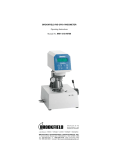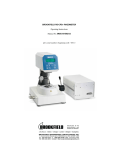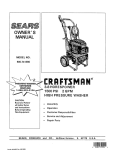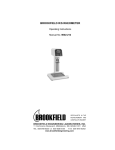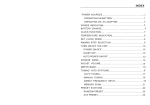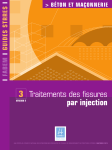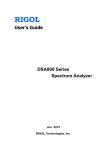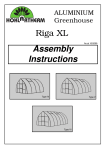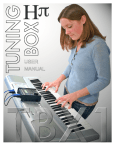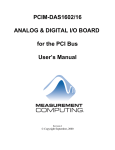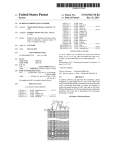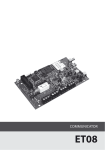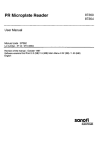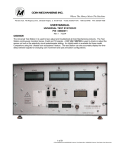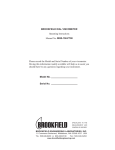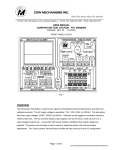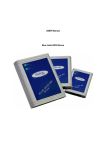Download BROOKFIELD R/S+ RHEOMETER Operating
Transcript
BROOKFIELD R/S+ RHEOMETER
Operating Instructions
Manual No. M08-219
(for serial numbers beginning with “304”)
SPECIALISTS IN THE
MEASUREMENT AND
CONTROLOFVISCOSITY
with offices in:
Boston•Chicago•London•Stuttgart•Guangzhou
BROOKFIELD ENGINEERING LABORATORIES, INC.
11CommerceBoulevard,Middleboro,MA02346USA
TEL 508-946-6200
FAX 508-946-6262
Brookfield Engineering Labs., Inc.
or 800-628-8139 (USA excluding MA)
INTERNEThttp://www.brookfieldengineering.com
Page Manual No. M08-219
Contents
I.
General Description............................................................................................................4
I.1 Use of the Rheometer................................................................................................. 4
I.2 Measuring Principle.................................................................................................... 4
II. System Configuration......................................................................................................... 5
II.1 R/S+ Rheometer.........................................................................................................5
II.2 Measuring Geometries............................................................................................... 7
II.3 Computer System....................................................................................................... 7
III. Instrument Installation....................................................................................................... 8
III.1 Mounting the Stand..................................................................................................... 8
III.2 Electrical Connections................................................................................................ 9
III.2.1 Temperature Sensor PT100............................................................................ 9
III.2.2 AC Adapter.................................................................................................... 10
III.2.3 Printer Connection......................................................................................... 10
III.2.4 Computer Connection................................................................................... 11
III.3 Connecting the Temperature Control Devices.......................................................... 11
III.3.1 Connecting the Water Jacket........................................................................ 11
III.3.2 Connecting the Optional Cone/Plate Attachment.......................................... 14
III.3.3 Connecting the KE Cooling Device............................................................... 16
IV.
Environment, Handling, Cleaning and Maintenance..................................................... 17
IV.1 Operating Environment and Storage........................................................................ 17
IV.2 Handling....................................................................................................................17
IV.3 Cleaning....................................................................................................................17
IV.4 Maintenance.............................................................................................................18
V.
Measuring Systems..........................................................................................................19
V.1 Measuring Directly in the Sample Container............................................................ 19
V.2 Measurement by Filling the Sample Cup.................................................................. 20
V.3 Measurement with Water Jacket Assembly.............................................................. 21
V.4 Measurement with Cone/Plate or Plate/Plate Measuring System............................ 22
VI.
Operation and Menu System........................................................................................... 24
VI.1 Keyboard..................................................................................................................25
VI.2 Menu System of R/S+ Rheometer............................................................................ 27
VI.3 Selecting from Lists ................................................................................................. 28
VI.4 Input of Numerical Values and Alphanumeric Texts ................................................. 29
VI.5 Menu Entries (MAIN menu) ..................................................................................... 30
VI.5.1 MAIN Menu → Run Single ............................................................................ 30
VI.5.2 MAIN Menu → Single Measurement ............................................................ 31
VI.5.3 MAIN Menu → Run Program ........................................................................ 33
Brookfield Engineering Labs., Inc.
Page Manual No. M08-219
VI.6
VI.7
VI.8
VII.
VI.5.4 MAIN Menu → Remote ................................................................................. 36
VI.5.5 MAIN Menu → Utilities................................................................................... 37
VI.5.7 MAIN Menu → Configuration ........................................................................ 37
Menu Entries in the Utilities Menu ........................................................................... 37
VI.6.1 Utilities → Zero Calibration ........................................................................... 37
VI.6.2 Utilities → Edit Program ................................................................................ 38
VI.6.3 Utilities → Print Programs ............................................................................. 42
VI.6.4 Utilities → Measuring Systems ..................................................................... 42
VI.6.5 Utilities → Print Memory ............................................................................... 43
VI.6.6 Utilities → Clear Memory .............................................................................. 44
VI.6.7 Utilities → Measure Temperature .................................................................. 44
Menu Entries of the Configuration Menu.................................................................. 45
VI.7.1 Configuration → Set Output Mode................................................................. 45
VI.7.2 Configuration → Set MeasCount Mode......................................................... 46
VI.7.3 Configuration → Set MeasCount................................................................... 46
VI.7.4 Configuration → Set Time/Date..................................................................... 46
VI.7.5 Configuration → Set RS232 Parameters....................................................... 47
VI.7.6 Configuration → Language............................................................................ 49
VI.7.7 Configuration → Service................................................................................ 49
Serial Data Transfer via the RS232 Interface........................................................... 49
Measurements...................................................................................................................51
VII.1 Measuring in Manual Mode...................................................................................... 51
VII.2 Measuring in with Water Jacket................................................................................ 51
VII.3 Measuring with Cone/Plate Attachment.................................................................... 51
VII.4 Measuring in Remote Mode...................................................................................... 51
VIII. Technical Data...................................................................................................................53
IX. Guarantee..........................................................................................................................55
Appendix A.................................................................................................................................56
A.1 Data Sheets of Standard Measuring Systems ......................................................... 56
A.2 Error Messages......................................................................................................... 58
A.3 Pin Assignment of the Serial Data Cable.................................................................. 61
A.4 Requirements to the AC Power Connecting Cables................................................. 61
Appendix B: Calibration Check Procedure............................................................................. 63
Appendix C: Warranty and Repair Service............................................................................. 71
Brookfield Engineering Labs., Inc.
Page Manual No. M08-219
I. General Description
This chapter has general information about the instrument and operating principle.
I.1
Use of the Rheometer
The R/S+ will measure viscosity of Newtonian and Non-Newtonian materials in controlled
shear rate (CSR) or controlled shear stress (CSS) modes. The instrument can measure simple
viscosity at a given speed or shear rate, or measure flow properties with a flow curve at shear
rates up to ~1,200 sec-1.
In controlled stress mode the instrument can do a direct yield test (stress ramp) and indicate
elasticity with creep/recovery tests.
I.2
Measuring Principle
The Rheometer R/S+ is a rotational steady state controlled shear stress rheometer which can be
operated in controlled shear rate mode.
Concentric cylinders, measuring cones and plates are available as measuring system. The
measuring sample is positioned in measuring gap between the stationary measuring cup and the
rotating measuring bob (Searle-principle), respectively between the rotating cone or plate and
the stationary lower plate (cone/plate, cone/cone measuring system).
The measuring drive developed for this instrument operates with a high dynamic precisiondrive- system with optical encoder without gearinng and without mechanical force transducers.
The R/S+ measuring drive can operate at a pre-set of speed (shear rate) or pre-set of torque
(shear stress). Measurements may be made in manual mode (without PC) or under PC control
with software RHEO3000. Note that creep measurements require computer system with software RHEO3000
Both CSR and CSS measurements can be carried out manually (without PC support) or with a
computer system and software RHEO3000.
Brookfield Engineering Labs., Inc.
Page Manual No. M08-219
II. System Configuration
The R/S+ Rheometer system consists of:
• Electronic unit and measuring drive integrated in one housing
• Stand with working surface
• AC Adapter
Available Accessories:
• Start-up and training service
• Printer
• Coaxial cylinder measuring system (see Appendix A)*
• Temperature measuring sensor Pt100*
• Water jacket assembly
• Bath/Circulator
• Computer system
• Software RHEO3000
• Vane spindles
*The accessories in bold print are necessary for a minimal configuration.
II.1 R/S+ Rheometer
The Rheometer electronics with measuring drive are built-in in one housing.
Instrument features include:
• Digital control of rotational speed and torque.
• Automatic adjustment of control parameters during measurement.
• Direct indication of measured and calculated values of speed/ shear rate, torque/shear stress,
viscosity, temperature, and time.
• Data storage (measured values)
• Data output to a printer (parallel).
• User support with LCD and keyboard
• Built-in system interface with serial standard interface (RS232-C) for connection to a computer or other serial data-logger.
• Printing and serial data-transmission during the test
The R/S+ Rheometer can either be operated manually using the keyboard at the front panel or
it can be operated under computer control. The R/S+ Rheometer is supplied with direct current
by the AC Adapter.
Brookfield Engineering Labs., Inc.
Page Manual No. M08-219
R/S+ Rheometer
1
2
3
4
5
6
7
8
9
10
11
12
13
14
R/S-CPS Rheometer
Measuring Bob Coupling
Mounting Flange
Pt100 Clamp Fixture (accessory)
Pt100 (temperature probe accessory)
Standard Measuring Bob (accessory)
Standard Measuring Cup (accessory)
Measuring Cup Bottm or Thread Protection (accessory)
Measuring Cup Screw Fitting
Stand
AC Adapter
Direct Current Plug (to rheometer head)
AC Power Cable
RS232 Cable (accessory)
Fig. II-1: Configuration of the R/S+ Rheometer
Brookfield Engineering Labs., Inc.
Page Manual No. M08-219
II.2 Measuring Geometries (Spindles or Bobs with Sample Cups)
Measuring devices are not included in base instrument price of Rheometer R/S+ and must be
ordered seperatly.
Measuring devices (cups and bobs) optionally supplied:
• coaxial standard measuring systems for R/S+ (see Appendix A) with and without built-in
temperature sensor Pt100
• Water Jacket Assembly for use of cylinder measuring system in temperature range -10°C to
+180°C
II.3 Computer System
The computer sytem is optional and provides automatic measuring, data plots, printing (full
reports or data plots) as well as analysis of results and quality control charts.
The recommended computer system consists of:
• IBM-compatible PC with the following minimal system requirements:
- CPU / 1 GHz minimum
- 512 MB RAM (main memory)
- 500 MB free hard disk capacity
- operating system Microsoft Windows 2000™, Windows XP™ or Vista™
- mouse and keyboard
- VGA graphic card and monitor
- 1 free serial interface
• Printer
• User Software RHEO3000
Brookfield Engineering Labs., Inc.
Page Manual No. M08-219
III.Instrument Installation
Setting up the R/S+ and taking first measurements:
- How to mount the Rheometer R/S+,
- Electric connections
- Installation of accessories such as bath circulator and measuring system
- Hose connections
III.1 Mounting the Stand
The stand consists of:
• the stand base plate
• the stand column with Rheometer
Hex-nut wrench size 6 and bolt DIN 912 M8x40 are supplied for mounting.
The stand column is connected to the stand base plate with a bolt. The proper orientation of the
column is set with a pin in the bottom of the column which fits into a hole on the stand base.
Rheometer
Temperature Sensor Pt100
Coaxial Cylinder System
AC Adapter
Stand
Base
Fig. III-1.: Rheometer R/S+ (minimum configuration)
Hints for height adjustment of the stand:
To change the height adjustment of the stand you release the clamp
handle and move the stand to the desired height. Caution: Hold the Rheometer as you release the clamp handle!
You can press the locking button to change the clamp handle position without screwing/unscrewing the thread. After adjustment of the
height screw tighten clamp handle thread.
Fig. III-2.: Stand Height Adjustment Hints
Brookfield Engineering Labs., Inc.
Page Manual No. M08-219
III.2 Electrical Connections
Connections for the electrical components of the R/S+ Rheometer are located on the back of
the instrument.
Interface for Printer Connection
Interface for Computer Connection
Connecting Socket for Pt100 Temperature Probe
Connecting Socket for AC Adapter
ON/OFF Switch
Fig. III-3: Operating and connecting elements at the back side of the measuring head
All cables from and to the R/S+ Rheometer must be connected or
disconnected only when the instrument is turned off!
III.2.1 Temperature Sensor PT100
The connecting cable for the temperature sensor Pt100 (100 ohm DIN alpha RTD) is
inserted into connector labeled “Pt100” at the back of the Rheometer.
If you use standard cylindric measuring cups (CC8, CC14 etc.), put the Pt100 into the
mounting clamp and fix it parallel to the measuring system at mounting flange of the
Rheometer.
Fig. III-4: Pt100 connection and mounting
Brookfield Engineering Labs., Inc.
Page Manual No. M08-219
Insert the plug of Pt100 connector labeled“Pt100” on the back of the Rheometer.
As the viscosity is a function of the temperature, the temperature should be measureed,
preferly in the test fluid. For this purpose, the standard measuring systems 8 mm to 40
mm DIN can be equipped with a Pt100 in measuring cup bottom (only when the water
jacket is used) If you use a measuring system with built-in Pt100, this is where you will
insert the cable VK-Pt/RC.
III.2.2 AC Adapter
Only the AC adapter originally supplied by Brookfield should be used to power the R/S+
Rheometer. Do not use a power supply other than the AC adapter delivered by Brookfield for the R/S+ Rheometer.
Connect the AC adapter using a grounded plug to avoid electric
shock or damage of the system components.
Connecting the AC adapter:
- Switch the R/S+ Rheometer off (“POWER” at the back side of the instrument).
- Connect the RS+ power cord into the AC adapter.
- Insert the socket of the DC cable into the connector “DC” at the back side of the R/S+
Rheometer.
- Plug the power cable into a grounded main socket.
- Turn the R/S+ Rheometer on.
Do not leave the power supply plugged when the cable to the rheometer is unplugged!
Before disconnecting Rheometer from AC supply be sure that the instrument is
switched off.
III.2.3 Printer Connection
Printer can be connected directly to the interface connector of the Rheometer when measuring without PC control. You must preset “Printer” as output device to print the measuring values during measurement (see Chapter VI). The printer should have a centronics
parallel interface. USB printers are not supported.
- Turn off the Rheometer R/S+ with the AC switch “POWER” at the back of the R/S+.
- Insert the printer connecting cable into the “PRINTER” port on back of the instrument.
- Turn the R/S+ Rheometer on.
Standard printer cable can be used as printer connecting cable. This cable is supplied with
the printer in most cases. To print data values from the Rheometer R/S+, any (parallel)
printer which can operate in ASCII character mode may be used.
Brookfield Engineering Labs., Inc.
Page 10
Manual No. M08-219
III.2.4 Computer Connection
If the Rheometer R/S+ has to be used in “REMOTE” mode with PC (RHEO3000 program package) or with serial data-terminal for data logging, the RS232 cable is connected
to the 25 pin port labled “RS232” on the back of the instrument.
− Turn the R/S+ Rheometer off with the “POWER” switch at the back of the instrument.
− Turn the computer system off.
− Connect the PC data cable to the 25 pin port labelled “RS232” on the back of the
R/S+ Rheometer.
− Connect the PC data cable to the port labelled “RS232/Peltier” on the back of the PTS control unit.
− Connect the other end of PC data cable with a free RS232 serial port (e.g. “COM2”)
on your computer.
− Turn the R/S+ Rheometer and your computer system on again.
You must use the computer cable supplied by Brookfield - other cables will not
work!
III.3 Connecting of Temperature Controlled Measuring Devices
This chapter discusses how to connect to following temperature control devices:
• Water Jacket Assembly for use of cylinder measuring system in the temperature range of
-10°C to +90°C (liquid’s temperature control)
• Cooling Device KE in conjunction with FTK/R/S+ temperature control device or CONE/
PLATE ATTACHMENT measuring device to raise the temperature range up to -20°C to
+180°C
III.3.1 Connecting the Water Jacket
As temperature control device is available optionally:
- Water jacket FTKY
for use of cylinder measuring system in the temperature range -10°C to +90°C.
The temperature water jacket should be used only in the
temperature range -10°C to +90°C unless the KE cooling device is
installed, in which case, the temperature range is -20°C to +180°C!
Brookfield Engineering Labs., Inc.
Page 11
Manual No. M08-219
Thread Joint for Mounting Flange
Hose Connection of Flow Output
Temperature Sensor Pt100
Thermostatting
Hose Connection of Flow
Measuring Cup Screw
Fig. III-5: Water Jacket Assembly
Mounting the Water Jacket Assembly:
• Turn off the R/S+ with the mains switch “POWER” at the back of the instrument.
• When using cooling device KE mount cooling device first (see Chapter 3.3.3)
• Set the jacket from below on the mounting flange of Rheometer R/S+ and tighten the
thread.
• Fix the hoses of liquid circulation thermostat at the jacket.
• Connect the jacket’s built-in Pt100 cable with the connector “Pt100” at the back of the
instrument of the R/S+ Rheometer.
Brookfield Engineering Labs., Inc.
Page 12
Manual No. M08-219
Cooling Device KE-FTK/RC30
Hose Connection of Flow
Temperature Sensor Pt100
Hose Connection of Flow
Water Jacket
Fig. III-6: Operation with FTK/RS+ and Cooling Device KE
Bath/Circulator Connection to the Water Jacket
Hose connections are necessary to connect the bath to the R/S+ water jacket.
The hoses are connected to quick fitting couplings on the jacket assembly (below: inlet;
above: outlet). The coupling has a female part which is put into the tubing, and a male
part built into the jacket assembly. To connect the two pull back on the female section
slide ring and put the connector onto the jacket (male) connector, releasing the slide ring.
Water jacket without cooling device KE must only be used in the
temperature range -10°C to +90°C!
The temperature control device FTK/R/S+ can be used in the temperature range -20°C to
+180°C when used with the optional KE cooler (for tap water cooling of the Rheometer
bearings)
It is recommended urgently to preset at liquid circulation thermostat the upper
temperature limitation: when using water at 90°C and when using oil at 180°C (only
with Cooling device KE).
Brookfield Engineering Labs., Inc.
Page 13
Manual No. M08-219
As thermostatic liquids are usually used:
-10°C to +90°C
Water (de-ionized) - Glycol Mixture
-20°C to +180°C
Thermostat Oil
Suitable bath fluids can be ordered from BROOKFIELD.
During measurements in the temperature range -10°C and above
+90°C, the water jacket may be put into operation only if the
cooling liquid flows through the KE cooling attachment in order to
prevent overheat of the measuring sensor.
III.3.2 Connecting the Optional Cone/Plate Attachment
• Turn off the R/S+ with the mains switch “POWER”.
• When using KE cooling device, mount the cooling device first (see Section III.3.3)
• Set the “CONE/PLATE ATTACHMENT” from below on the mounting flange and
tighten the thread. Check that before tightening the guide pin of the measuring device
(see Fig. III.7) must be in the slot of the R/S+ mounting flange!
• Fix the hoses of liquid circulation thermostat at the “CONE/PLATE ATTACHMENT”.
• Insert the temperature sensor cable of “CONE/PLATE ATTACHMENT” in the plug
socket “Pt100” at the back of the instrument of the Rheometer R/S+.
• For mounting cone/plate or plate/plate measuring systems to measuring device refer to
Section 5.
Bath/Circulator Connection to the Cone/Plate Attachment
The hoses are connected to quick fitting couplings on the cone/plate assembly (below: inlet; above: outlet). The coupling has a female part which is put into the tubing, and a male
part built into the jacket assembly. To connect the two pull back on the female section
slide ring and put the connector onto the jacket (male) connector, releasing the slide ring.
The measuring device CONE/PLATE ATTACHMENT without
cooling device KE COOLING ATTACHMENTmust only be used
in the temperature range –10°C to +90°C.
We suggest that when using a bath/circulator the high limit cut-off be at 90°C or 180°C
depending on liquid (water or bath oil).
Brookfield Engineering Labs., Inc.
Page 14
Manual No. M08-219
As thermostatic liquids are usually used:
-10°C to +90°C
Water (de-ionized) - Glycol Mixture
-20°C to +180°C
Bath Oil
Suitable bath fluids can be ordered from BROOKFIELD.
During measurements in the temperature range below
-10°C and above +90°C, the measuring device CONE/PLATE
ATTACHMENT may be put into operation only if the cooling
liquid flows through the the KE COOLING ATTACHMENT in
order to prevent overheat of the measuring sensor.
Guide Pin
Screw Connection for
Mounting Flange
Hose Connections for
Temperature Fluid Circulation
Fig. III-7: Measuring Device CONE/PLATE ATTACHMENT for cone/plate and plate/plate systems
Brookfield Engineering Labs., Inc.
Page 15
Manual No. M08-219
III.3.3 Connecting the KE Cooling Device
The optionally supplied cooling device KE COOLING ATTACHMENTmust be used
where test temperature is to be below -10°C or above 90°C. When using KE COOLING
ATTACHMENTthe temperature range can be expanded up to -20°C to +180°C.
The cooling liquid flows through the cooling channel of the cooling device and cools the
instrument bearings/electronic parts.
Connecting
• Turn off the R/S+ with the mains switch “POWER”.
• Lift the KE COOLING ATTACHMENTfrom below to the R/S+ Rheometer and tighten
the thread.
• Fix the hoses of the cooling loop at the KE COOLING ATTACHMENT(see below
“Cooling water connection to cooling device KE).
Cooling Device KE
Hose Connection
Fig. III-8: Cooling Device KE
• The hoses of cooling circulation loop are connected with by quick fitting coupling
swith the cooling device “KE”.
During measurements in the temperature range below -10°C and
above +90°C, the cooling device KE must be used!
Brookfield Engineering Labs., Inc.
Page 16
Manual No. M08-219
IV. Environment, Handling, Cleaning and Maintenance
This chapter covers the environment, handling, cleaning and maintenance of your RS+ Rheometer.
IV.1 Operating Environment and Storage
Find a comfortable, convenient work place for the installation of the R/S+ Rheometer. There
should be enough room to place the Rheometer, the measuring systems, the measuring substances and the peripheral devices (e.g. printer, computer and bath/circulator). You need a
grounded AC plug to operate the R/S+ Rheometer. You also need an additional plug for the
connection of each peripheral device. Your operating environment and the place where you
store the R/S+ Rheometer should not be extremely hot, extremely cold or extremely moist.
Places with strong temperature and air humidity fluctuation should also be avoided. Be sure
that the R/S+ Rheometer is not exposed to the following:
• heavy dirt or dust
• direct sun radiation
• objects that emit strong heat (e.g. heating radiators)
• objects with a strong electromagnetic field (e.g. loudspeakers, motors etc.)
• liquids or corrosive chemicals
IV.2 Handling
The R/S+ Rheometer is designed to work under light bumps or with vibration. You must, however, avoid dropping it or exposing it to heavy shock!
Never lift your RS+ Rheometer at the measuring bob couping or a builtin measuring bob. Avoid everything that might impair the free and
concentric rotation of the measuring element coupling (e.g. shock).
The rheometer motor will automatically turn off it maximum torque (50 mNm) is exceeded.
IV.3 Cleaning
The paint coat of the R/S+ Rheometer resists attack by most usual solvents and weak acids.
Use a dry, clean, soft and nap-free piece of cloth to clean the housing. Use neutral detergent
liquids and a piece of soft cloth in case of heavy soiling of the housing.
Brookfield Engineering Labs., Inc.
Page 17
Manual No. M08-219
Do not use chemical products such as strong solvents or strong acids to
clean the housing, especially the operating field with the foil keyboard.
Make sure no liquid penetrates into the housing (e.g. through the
instrument connecting sockets) and into the bearings of the measuring
drive.
IV.4 Maintenance
The R/S+ Rheometer system is designed for long-term operation. Should the instrument require repair, contact Brookfield or your Brookfield dealer.
Work on control electronics, all accessories, the measuring drive
as well as with the AC Adapter and all electric circuits and
connections may only be done by authorized service personnel!
Measurement accuracy can be checked by the customer at any time. We recommend that measurement be done with standard oils (mineral oil or silicone) such as Brookfield fluid 1000 CPS
(~ 1.0 Pa•s)
You must use temperature control (i.e., water jacket and bath) and we recommend the 40 mm
cup and bob.
Select the appropriate measuring system.
Carry out measurements at the following preset M (‰ torque): 250‰, 500‰ and 950‰
Read viscosities from the display.
In case of instrument failure (or severe deviation from the preset value), contact Brookfield or
your Brookfield Dealer.
Brookfield Engineering Labs., Inc.
Page 18
Manual No. M08-219
V. Measuring Systems
This chapter covers the use of the measurement system (cups and bobs or spindles and samplel
chambers). The following measuring systems are available:
a) Standard immersion measuring systems with bob diameters from 8mm to 40 mm and
double gap for measurement without temperature water jacket and bath/circulator consisting of:
• measuring cup
• measuring cup bottom
• measuring bob
b) Standard measuring systems with bob diameters from 8mm to 40 mm and double gap for
measurement with temperature control device FTK/R/S+ consists of:
• measuring cup
• bottom cap
• measuring bobs
• optionally Pt100 temperature sensor in measuring cup bottom or water jacket assembly
c) Disposable measuring system for bob diameters from 8mm to 40 mm for measurement
with temperature control consisting of:
• measuring cup mounting (holder for disposable disposablecups)
• disposable measuring cup (aluminium)
• measuring cup ejector (aka pusher)
• measuring bob
d) Cone/plate measuring system for 25 mm and 50 mm cones for measurement with measuring device CONE/PLATE ATTACHMENT consisting of:
• measuring cone
e) Plate/plate measuring system for 25 and 50 mm plate for measurement with measuring
device CONE/PLATE ATTACHMENT consisting of:
• measuring plate (P25/30, P50/30) depending on measuring system
Please select a suitable measuring system for the desired measuring range to carry out measurements. (for details of measuring systems ranges refer to Appendix A).
V.1 Measuring Directly in the Sample Container
You may immerse the measurement system directly into a container of sample by removing the
cap on the bottom of the immersion cups.
When using the measuring system double gap bob do not damage the “O” ring which forms
the seal between the inner and outer parts of the sample cup.To clean the inner section is
Brookfield Engineering Labs., Inc.
Page 19
Manual No. M08-219
removed by unscrewing the (stainless steel) ring at the bottom and then GENTLY pushing the
inner section out the bottom of the outer section. Take care not to damage or stretch the O-ring
seal during removal! Insert the inner part again and screw the measuring system.
• Lift the coupling sleeve of the measuring bob coupling (ring visible).
• Insert carefully the measuring bob into the measuring bob coupling. Pay attention to insert
the measuring bob shaft into the measuring bob coupling without impact.
• Lower the coupling sleeve of the measuring bob coupling(ring covered).
• Fasten the measuring cup at the measuring cup mounting flange with the measuring cupl
thread.
• Immerse the measuring cup into the substance up to the ring mark or up to the point where
diameter of measuring cup increases.
Fig. V-1: Depth of immersion
Do not get sample in or onto the measuring bob coupling, or measuring drive or electronics.
After the end of measurement, unscrew the measuring cup thread and remove measuring cup.
Then open the measuring bob coupling and remove the measuring bob.
Clean measuring cup and measuring bob carefully. Do not use hard objects, always prevent
scratches! Store measuring bobs on a soft pad.
V.2 Measurement by Filling the Sample Cup
Fill the measuring cup with substance (sample filling quantity see Appendix A1 “Data sheets
of the standard measuring system”). Avoid air bubbles when filling in the sample as they can
(badly) effect the repeatability of the test!
Place the measuring bob in measuring cup. Lift the coupling sleeve of the measuring bob coupling (ring visible). Insert the complete measuring system from below into the measuring cup
mounting flange and screw tight using the measuring cup thread. Insert the measuring bob shaft
into the measuring bob coupling without impact. Now insert the measuring bob shaft completely into the measuring bob coupling and move down the coupling sleeve of the measuring bob
coupling (ring is covered).
If you want to measure with temperature control, the bath/circulator must be pre-set at the deBrookfield Engineering Labs., Inc.
Page 20
Manual No. M08-219
sired temperature and you should wait until bath liquid and sample are at test temperature.
Now the measurement can be carried out.
To remove the measuring system after the measurement first open the measuring bob coupling
and then unscrew the measuring cup thread.
If you have carried out measurements at very high or very low
temperatures, please take care as some surfaces can become very hot or
very cold. Before removing the measuring system, please wait until the
system-surface temperature equalized to nearly room temperature to
avoid injury.
When unscrewing the measuring cup, you must hold the measuring
system tightly with one hand to avoid dropping the cup and bob!
Clean the measuring cup and measuring bob carefully without using hard objects to avoid
scratches! Store the measuring bobs on a soft pad.
V.3 Measurement with Water Jacket Assembly
In case of disposable measuring systems insert the disposable measuring cup into the measuring cup mounting. Fill the measuring cup with substance (sample filling quantity see Appendix
A1 “Data sheets of the standard measuring system”).
Avoid air bubbles when filling in the sample as they can (badly) effect the repeatability of the
test!
Place the measuring bob in measuring cup. Lift the coupling sleeve of the measuring bob
coupling (ring visible). Insert the complete measuring system from below into the temperature
control device and screw tight using the measuring cup screw. Insert the measuring bob shaft
into the measuring bob coupling without impact. Now insert the measuring bob shaft completely into the measuring bob coupling and move down the coupling sleeve of the measuring bob
coupling (ring is covered).
The water bath must now be pre-set at the desired temperature and you should wait till the test
temperature is achieved (e.g. temperature measurements through the Pt100 menu point “Utilities->Meas.-Temperature” see Section 6). Now the test may be run.
To remove the measuring system after the measurement first open the measuring bob coupling
and then unscrew the measuring cup screw of temperature control device.
Brookfield Engineering Labs., Inc.
Page 21
Manual No. M08-219
If you have carried out measurements at very high or very low
temperatures, please take care as some surfaces can become very hot or
very cold. Before removing the measuring system, please wait until the
system-surface temperature equalized to nearly room temperature to
avoid injury.
When unscrewing the measuring cup, you must hold the measuring
system tightly with one hand to avoid dropping the cup and bob!
When using disposable measuring cups, eject the disposable measuring cup with the pusher.
Clean the measuring bob carefully, do not use hard objects to prevent scratches!
Store measuring bobs on a soft pad.
V.4 Measurement with Cone/Plate or Plate/Plate Measuring Systems
Installing and adjusting of the measuring cone or measuring plate
To install any measuring cone or plate the bayonet lock must be released (position “opened”)
and the lower plane-table must be displaced down.
During release of the bayonet lock the measuring device has to be hold
tight at the lower part. Otherwise the plane-table is falling down on its
own.
Unlock the inner hexagon screw on shaft of the spindle (e.g. cone C50-1/30, plate P25/30 and
others) to be inserted. Correct the length to the minimum, which can be adjusted, and tighten
the shaft at this position by moderate forces.
Lift the coupling sleeve (red ring mark visible). Insert the measuring spindle (cone or plate)
from below into measuring coupling. Move down the coupling sleeve (ring covered) in order to
fix the spindle.
Turn the adjusting screw on plane-table down to the lowest position. Remove the plane-table
in top end position again, and fix it by bayonet lock (position “closed”).
The actual distance between spindle and plane-table has to be reduced to approx. 1 mm by
turning upwards the adjusting screw. Stop the upwards movement at a reasonable screw mark
“0” on scale of adjustment screw.
Brookfield Engineering Labs., Inc.
Page 22
Manual No. M08-219
After this the dial indicator should be also set to mark “0” for distance control. Unlock the
spindle shaft again, which brings the spindle in touching position on the plane-table. Lock the
hexangon screw to fix the shaft.
The plane-table must now be lowered by 0.5 mm with ajustment screw (equivalent to one
revolution). From the lower position turn upwards again, but stop at screw mark “5” (50 µm),
which corresponds for the correct cone distance for measurements. Other distances, which
are required using a measuring plate (e.g. P50/30), have to be choosen by the same procedure
– start always one revolution (0.5 mm) below final measuring position.
Measurement
Open the bayonet lock and lower the plane-table. Apply the desired measuring substance. Lift
up the plane-table and fix the bayonet lock. Now, the measurement can start.
Remove excess sample from around the cone or plate before starting the
measurement.
If temperature control is required, a bath/circulator is connected. The bath must be set at the
desired temperature, and you should wait until the bath has reached test temperature.
Brookfield Engineering Labs., Inc.
Page 23
Manual No. M08-219
VI.Operation and Menu System
The following section summarizes the operation and the menu system of the R/S+ Rheometer
for both manual and PC-controlled measurement.
Menu prompts for the R/S+ Rheometer are available in the following languages:
• English
• German
The language is selected via the menu level Configuration→Language (if English is active)
or Konfiguration→Sprache (if German is active). For more details on language selection, see
Chapter VI.7.6.
After applying power to the R/S+ Rheometer, the LCD displays the following information for
a few seconds:
• name of the Rheometer
• software version of the firmware installed in the instrument
• serial number of the instrument
• date and time
Example:
R/S+ Rheometer
Ver.: 9.00
#xxxxxx
27.01.08
15.12
©Brookfield Engineering
About five seconds later, the instrument checks the voltage of the power supply. The displayed
voltage should be in the range of 14.9 to 16V. If the voltage is outside this range, contact
Brookfield or your local Brookfield dealer.
Example:
Voltage Check:
VCC:15.25 V
This message is displayed for about 3 seconds and then the MAIN menu is displayed. A brief
summary of the Rheometer keyboard and the corresponding Rheometer functions may be helpful before you get to the complete description of the menu in Section VI.4.
Brookfield Engineering Labs., Inc.
Page 24
Manual No. M08-219
VI.1 Keyboard
MAIN MENU
- Single measurement
- Program measurement
- Remote
>
R/S + RHEOMETER
- Select previous menu entry
- Input: increment numerical
value/letter
ON
ST
- Select next menu entry
- Input: decrement numerical
value/letter
OK
- One digit to the right
START/STOP
- Back to parent menu
- Abort
- Start of measurement
- Abort measurement
OK
- Accept
- Select
- One digit to the left
All user inputs are made using the six keys located below the LCD. Some of the keys are of
multiple use, i.e. their function depends on the current operation. The following table shows
the keyboard functions in detail.
Keypad layout of the R/S+ Rheometer
Key
Operation
Function of Key
Example
1) Menu 1) Goto previous menu
entry (above active one)
1) Utilities → Remote
2) Input of numerical values
2) Increment
2) 8 → 9
A→B
3) Selection from list
3) List entry above active
entry (previous)
3) Select meas. system
CC25/30 → CC37/30
1) Menu 1) Goto next menu entry
(below active one
1) Remote → Untilities
2) Input of numerical values
2) Decrement
2) 5 → 4
F→G
3) Selection from list
3) List entry below active
entry (next)
3) Select meas. system
CC37/30 → CC25/30
1) Menu 1) Goto previous menu
1) Utilities → Remote
entry (above active one)
2) Input of numerical values
2) One digit to the right
2) 100.00 → 100.00
Test → Test
3) Selection from list
3) List entry above active
entry (previous)
3) Select meas. system
CC25/30 → CC37/30
Brookfield Engineering Labs., Inc.
Page 25
Manual No. M08-219
Key
Operation
Function of Key
Example
1) Menu 1) Goto next menu entry
(below active one)
1) Remote → Utilities
2) Input of numerical values
2) One digit to the left
2) 100.00 → 100.00
Test → Test
3) Selection from list
3) List entry below active
entry (next)
3) Select meas. system
CC25/30 → CC37/30
1) Menu
1) Return to parent menu
(turn page downward)
1) Utilities → Main
2) Input of numerical 2) Break input values
(only if possible)
ST
OK
3) Selection from list
3) Break selection
(only if possible)
3) Select meas. system →
back to menu
4) Measurement
4) Start and Break measurement
4) Break when measuring
5) Remote operation
5) Break measurement
back to main menu
1) Menu
1) Select active menu level (open sub-menu)
2) Input of numerical 2) End of input/acceptance
values
3) Selection from list
Brookfield Engineering Labs., Inc.
3) Select active list element
Page 26
Manual No. M08-219
VI.2 Menu System of R/S+ Rheometer
Main
Menu
Run Single
Run Program
Remote
Utilities
Measurement at constant shear rate
or shear stress
Measurement with pre-defined
programs
Measurement under PC control
Zero
Calibration
Edit
Programs
Creation/editing of programs
(ramp functions included)
Print
Programs
Printing program parameters of
existing programs
Measuring
Systems
Creation/editing of measuring
system factors
Print
Memory
Printing of measuring data from
memory
Clear
Memory
Clearing of measured data from
memory
Measure
Temperature
Configuration
Zero-point calibration
Display temperature
Set Output
Mode
Pre-select output of measuring
data via printer or RS232
Set MeasCount Mode
Selection of measuring counter
mode
Reset MeasCount
Reset measuring counter
Set Time/Date
Setting of time and date
Set RS232
Parameters
Setting of transmission parameters for RS232
Language
Language selection for user
prompts
Service
Service2
Only for service personnel!
Brookfield Engineering Labs., Inc.
Page 27
Manual No. M08-219
Menu Handling
Since the LCD of the R/S+ Rheometer cannot show all menu items simultaneously, only three
entries are displayed on the menu at a time. Arrows (>) on the right side of the display indicate
that there are more menu entries. The arrow on the 2nd line indicates there are more menu
entries above and the arrow on the 4th line indicates more menu entries below.
The currently active (but not yet selected) entry is marked by a blinking field (cursor) on the
left side of the LCD.
Example:
Active entry: press
OK to select
MAIN-Menu
Run Single
-Run Program
-Remote
>
This menu contains
additional entries
Using the
and
keys, you can move the cursor up and down in the menu until the desired menu entry is reached.
Note: If there are more menu entries in the menu when you have reached the end of the display, the next part of menu will be opened automatically (scrolling).
You can “start” the menu entry by pressing the OK key, as well as open the related sub-menu.
If you are in a submenu and wish to return to the upper menu, press the ST key.
VI.3 Selecting from Lists
The same keyboard and display functions that are in the menu apply if you have to select a preexisting entry from a list. Selection from a list is required for the following:
• Select a measuring system for measurement, e.g.in “Run Single” or “Edit Program”
• Select pre-set values for measurement, e.g. in “Run Single” or “Edit Program”
• Select a program or a measuring system you want to edit in “Edit Program” and “Measuring Systems”
• Answer a request “YES” ↔ “NO”.
• Select the program to be started in “Program Measurement”
The
and
keys move the cursor up and down the list.
The OK key selects the entry, ST Breaks the selection from the list (only if possible).
Brookfield Engineering Labs., Inc.
Page 28
Manual No. M08-219
Example:
Select Meas.system:
1) DG DIN
2) CC40
3) CC25
>
>
VI.4 Input of Numerical Values and Alphanumeric Texts
Most user defined entries are numbers. User defined values such as the Start and End values
of a ramp, number of measuring points, factors, time, date etc. are entered as numbers with or
without decimal digits.
If the display shows the decimal point in a number to be entered, input of a floating-point number is requested. However, the number of digits after the decimal point is limited to the number of displayed decimal digits; i.e. the decimal point cannot be moved during input.
The digit to be changed is indicated by a bar under the digit.
The following example indicates the input of numerical values. We will change the value of
shear rate (Val.[1/s]) from 0100.00 to 290.00.
In the following example, the cursor bar is located under the“1” in the entered shear rate (currently 100.00 s-1).
Input of Values:
Val.[1/s]: 0100.00
Nr. of MP: 010
Time[s]: 0100
The “1” can be changed (incremented or decremented) by using the
Press the
and
keys.
key once to get:
Input of Values:
Val.[1/s]: 0200.00
Nr. of MP: 010
Time[s]: 0100
The cursor can be moved right or left by using the
press the
and
keys. To change the next digit,
key:
Input of Values:
Val.[1/s]: 0200.00
Nr. of MP: 010
Time[s]: 0100
The next digit can now be changed. In order to insert “9” in place of “0”, press the
once:
Brookfield Engineering Labs., Inc.
Page 29
key
Manual No. M08-219
Input of Values:
Val.[1/s]: 0290.00
Nr. of MP: 010
Time[s]: 0100
Note: If you press and hold one of the keys
or
while entering numbers, the digit will
first increment or decrement by +/- 1. However, after a short period of time, the process
will continue automatically. This corresponds to the Repeat Function of computer
keyboards.
In this example,
could be pressed and and held until the “9” is displayed. The
repeat function is only active during numerical and alphanumeric input.
When the desired number is displayed, accept it by pressing the OK key: the cursor now moves
to the first digit of the next field to be entered.
Alphanumeric inputs
Some fields allow for both numbers and letters. These are entered the same way as previously
discussed for numeric fields. The available entries are: 0 through 9, A through Z, and the
blank symbol “ ”. If you wish to change the letter “B” to the number “7”, press and hold the
or
keys until the “7” appears at the display.
Alphanumeric input is available when assigning a name to a user definedprogram, or an ID to a
user defined test measurement.
VI.5 Menu Entries (MAIN menu)
Menu entries (see Section VI.2) either lead to submenus (e.g. “Utilities” or “Configuration”), or
they start one of the Rheometer’s functions directly.
All gray fields in the tree chart in Section VI.2 that have no further right branches start functions. Those with right branches are submenus.
Recall the keyboard layout from Section VI.2. By pressing
and
the cursor (black rectangle) moves up and down. The OK starts a function. If a submenu is assigned to the entry
it will open, otherwise the function of the Rheometer is started. The functions of the R/S+
Rheometer are described in detail in this section.
VI.5.1 MAIN menu → Run Single
This function carries out a measurement of shear stress or shear rate at a constant preset
values. The physical units of preset values may be selected from:
•Shear Rate
D[s-1]
•Speed
n[rpm]
Brookfield Engineering Labs., Inc.
Page 30
Manual No. M08-219
•Shear Stress
•Torque
Tau [Pa]
M [‰]
[1000 ‰ correspond ca. 50 mNm]
After actuating the main control switch of the Rheometer followed by a view seconds
required initial self-test (Chapter VI) the start display indication is reached automatically:
Adjustable Temperature
Set Value
Error Indication
(00 = no error)
THERMOSTAT
TS: 20.0
p/q
T: 20.0
Status: 00
Info on Temperature
Value That Can Be Varied
Permanent Indication of
Actual Temperature Value
The last adjusted set point TS is always saved when the Rheometer is turned off. When
the Rheometer is re-started, the Peltier will return to the last set point.
Independent from running control algorithm, the choice to modify the set point temperature with the
and
keys is always at the user’s disposal.
The temporary flashing of three points • • • confirms an acceptance of the new set temperature value:
THERMOSTAT
TS: 45.0
...
p/q
T: 20.0
Status: 00
Confirmation of Modified
Set Temperature Value
Another re-adjustment of actual temperature value starts afterwards. The main menu can
be re-entered with the keys ST and OK .
VI.5.2 MAIN menu → Single Measurement
This function measures shear stress or shear rate (CSS or CSR) at constant user defined
values. The user may select the physical unit from the following:
Shear Rate
Speed
Shear Stress
Torque
D [s-1]
n [U/min] or [rpm]
Tau [Pa}
M[‰] [1000 ‰ correspond to 50 mNm]
The following entries need to be made before measuring:
• selection of the measuring system (see Section VI.3)
• selection of physical unit (see above and Section VI.3) to determine either a controlled rate measurement (shear rate, RPM) or a controlled stress measurement (shear
stress, torque).
• input of user defined values (input of numbers, operation, see Section VI.4)
D [s-1] range of values depends on the measuring system
Brookfield Engineering Labs., Inc.
Page 31
Manual No. M08-219
Before you start the measurement itself, you have to input the following values:
• Selection of the measuring system used (selection from the list, operation, see Section
VI.3)
• Selection of physical units of preset value (see above, selection from the list, operation, see Section VI.3). This is where you decide if you want to carry out a shear rate
measurement (shear rate, speed) or a shear stress measurement (shear stress, torque).
• Input of preset values (input of numbers, operation, see Section VI.4).
- D[s-1]
The range of value depends on the measuring system
- n[rpm]
0.1 to 1,000 rpm (U/min)
- Tau [Pa]
The range of the value depends on the measuring system
- M [‰]
0 to 999 ‰
•Input of desired number of measured points (input of numbers, operation, see Section 6.4). Input of the measurement duration in seconds. the minumum time interval
depends on kind of the measurement and on number of measurement points. The
minimum time between 2 measurement points are:
- shear rate measurement
tMP >= 4 s
- shear stress measurement tMP >= 1 s
Note: The longer the time between two measured values, the higher the accuracy
of the physical values determined!
• Input of ID (15 character maximum) for the Test Measurement (alphanumeric input,
operation - see Section VI.4)
If you have passed these points before starting a measurement, the Rheometer will indicate where the measure points will be written to:
Output of MPs to:
- no output-device
- memory
< >menu
<ST>START_
Start a measurement by pressing the ST key or return to the main menu with the
key.
This example shows that the measurement data will be written into the instrument
memory. Output devices are either a printer or the RS232 serial interface of the Rheometer. Pre-selection of these devices is described in the Section “Configuration → Output
mode”.
If the memory is full and you want to keep the data, you should Break the “Single Measurement” function, print out the data from the memory or send the data to a PC (see
“Utilities → Print Memory”). Then you may clear the data from the memory (see chapter “Utilities → Clear Memory”) and run your test.
Tests may run with full memory but the results will not be saved. They will be shown on
the LCD as they come from the instrument.
Brookfield Engineering Labs., Inc.
Page 32
Manual No. M08-219
When a measurement is started, the instrument shows:
Program running
Wait for 1.MP
#01
This message will be displayed until the first measuring point is reached and displayed.
Torque
Duration
100.5 ‰
000.90 1/s
Eta:
1.728Pas
Tau:
1.572Pa
04s
20.7°C
#01
User defined value
Measurement results
Step (in single meas.
always 01)
Temperature
If the torque is below 10 ‰ (scale is 0‰ to 1,000‰), the measurement results are often
inaccurate. In this case the user defined parameters should be changed so the torque is
higher than 10%.
If the display field for the torque indicates: “Mlow!”, these values are below the range of
resolution of the Rheometer.
If the temperature is not displayed, the measuring sensor is not connected and will print
as “1000.0°C” in the printout.
The display is updated every new measuring point. The current measurement can be
cancelled at any time with the ST key.
After a measurement or a break, the display field for Step indicates “END” or “BREAK”.
The display alternates at intervals of about four seconds between the last displayed measuring point and information about the measurement:
Reason for
break or end
Duration until
break or end
Program end
Single mode
Total time:
Total #MP:
100s
10
Type/name of
executed progr.
Number of measuring
points measured
By pressing OK you stop the alternating display and return to the menu.
Note: The last selected program parameters remain in the memory even after switching
off the Rheometer.
VI.5.3 MAIN menu → Run Program
This function starts measurements, which were previously defined as a program. Contrary
Brookfield Engineering Labs., Inc.
Page 33
Manual No. M08-219
to “Run Single”, here you can also set values as a linear function of time, for example
D[s-1] = f(t). It is advisable to use function Run Program always when you want to carry
out repeating measurement series with the same preset values and with the same measuring system. The second option is used when a user can carry out measurement without
large previous information of rheology. Actually, not every person, starting a measurement, has unlimited possibilities to determine correct preset values and measurement
system for a medium under study (optimal use of measurement range, irreversible rheological changes of the substance studied, etc.). 4 standard programs can be defined. How
to define or to edit pragram is described in Section “Utilities → Edit Program”.
Function Run Program starts one of the programs defined in memory. If there is no program available, the following error message is displayed:
No valid program
Enter program first!
In such a case you have to define a program first (“Utilities → Edit Program”). Use
to return to the main menu.
OK
If programs are available, a list appears to select from. Select the program to be started
(selection from the list, operation, see Section VI.3).
Select PROG to run
1) Prog xyz
2) Test
3) Prog oil 2000
If the OK key is used to select the program (in this example, the program named “Test”),
this operation is followed by the option to enter an ID (identification text of the measurement). A name for the measurement may be entered here (maximum 15 characters - for
alphanumeric input, see Section VI.4).
Meas. series
identification
Input measuring id
ID-number: 125
ID: OIL2000 040596
Automatic increment at
every measurement
If you have passed these points before starting a measurement, the rheometer will indicate where the measure points will be written to.
Brookfield Engineering Labs., Inc.
Page 34
Manual No. M08-219
Output of MPs to:
- Printer
- memory
< >menu
<ST>START_
Start a measurement by pressing ST or return back to the main menu with
.
In the above example, the measurement points will be saved to memory and printed to
the printer connected to the Rheometer. Options for output devices include a printer,
the RS232 serial interface or no output device. The section, “Configuration → Output
mode”, describes this in detail.
If the memory is full, you should consider cancelling the “Program measurement” function, printing the data from the memory or sending it to a PC (see chapter “Utilities →
Print memory”) and then clearing the data from the memory (see “Utilities → Clear
memory”).
Measurements can be taken with the memory full but the results will only be shown at the
LCD and will be lost after completion of the measurement. If you try to send results to
a printer and it is not connected or has no paper in it, an error message will be displayed
until the printer is connected and operational or until you break the activity.
When you start the measurement the instrument shows:
Program running...
Wait for 1.MP
#01
This message will be displayed until the first measuring point is displayed.
Torque
Duration
100.5 ‰ 000.90 1/s
Eta:
1.728 Pas
Tau:
1.572 Pa
05s
20.7°C
Actual pre-set value
Measurement result
#01
Current step
Temperature
If the torque is less than 30 ‰, the results may be out of instrument range. The user
should consider changing the user defined values to get a torque higher than 10 ‰.
If the display field for the torque indicates: “M low!”, these values are below the range of
resolution of the Rheometer.
If the temperature is not to displayed, the measuring sensor is not connected and the
printout of the temperature will be printed as 1000.0 °C!
Brookfield Engineering Labs., Inc.
Page 35
Manual No. M08-219
The display is updated at every new measuring point. The current measurement can be
cancelled at any time with the ST key.
After measurement, or after a break, the display field for step indicates “END” or
“BREAK”. The LCD alternates at intervals of about four seconds between the last displayed measuring point and information on the measurement:
Reason for
break or end
Duration until
break or end
Program end
Single measurement
Total time: 200s
Total #MP:
40
Type/name of
executed progr.
Number of measuring
points measured
Pressing OK ends the alternating display and returns to the main menu.
VI.5.4 MAIN menu → Remote
The “Remote” function initiates measurements to be made under PC control. In this
mode, all functions of the R/S+ Rheometer are controlled by a PC. For PC-controlled
measurements, you need the software package RHEO3000. This software operates under
Microsoft Windows 2000™, Windows XP™, and Vista™. More detailed information on
RHEO3000 software can be obtained from your Brookfield or an authorized dealer.
After selecting the Remote option, the Rheometer displays the following:
Remote
Wait for RS232...
<ST>=stop
The Rheometer waits for communication with a PC. Data transfer between the PC and
the Rheometer is performed through the RS232 serial interface of the R/S+ Rheometer.
If RHEO3000 is installed on the PC, the REMOTE (MEASURE) program can be run and
this operation can be ended at any time by the ST key. The current measurement is also
cancelled by pressing the ST key in REMOTE operation.
On completion of the communication with the PC, the LCD shows: “Remote done ...”
Pressing the key ST will return the display to the Main Menu.
During measurement in REMOTE operation, the LCD will display various information which to provide troubleshooting information in case errors occur; this information
should be disregarded.
Brookfield Engineering Labs., Inc.
Page 36
Manual No. M08-219
VI.5.5 MAIN Menu → Utilities
Entry to open the “Utilities” submenu - see Section VI.6.
VI.5.6 MAIN Menu → Configuration
Entry to open the “Configuration” submenu - see Section VI.6.
VI.6 Menu Entries in the Utilities Menu
The Utilities menu contains several useful functions:
Zero Calibration
Initiates the zero calibration procedure of the rheometer
Edit Programs
Input or modification of programs which are started with Run Program
Print Programs
Prints all parameters of all the programs in memory to the printer
Measuring Systems
Print Memory
Delete Memory
Meas. Temperature
Input of measuring system parameters or generation of new measuring systems
Output of data in memory to the printer or to the serial interface
Clears all data from memory
Measures temperature without running a measurement
The following sections explain these options in more detail.
VI.6.1 Utilities → Zero calibration
The function “Zero calibration” serves to calibrate the Rheometer zero point. This function continues for approximately 10 minutes and should be done once a week.
Before starting this function, be sure the R/S+ Rheometer has warmed
up for at least 10 minutes, and that NO measuring element is in the
measuring element coupling.
Confirm the command that the measuring system is removed by pressing the OK key
(start of zero point calibration), or press the ST key to return to the Utilities menu.
Zero point calibration will proceed automatically and comprises several measuring series
at different speeds. The progress of calibration is shown by the number of executed steps
of the total steps. If an error message appears during zero calibration, repeat the zero
calibration. If the error message is displayed again there may be a technical fault (→
Repairs).
Brookfield Engineering Labs., Inc.
Page 37
Manual No. M08-219
After successful calibration, the values of the zero point are stored internally. These values are preserved until the next calibration.
Press the OK key to save values. Press any other key to return to the Utilities menu without saving.
Note: You can cancel zero point calibration at any time with the ST key. The zero point
values determined up to that point will be ignored.
VI.6.2 Utilities → Edit Program
This function allows the input of new, and the modification of existing programs. The
programs may be run after successful creation via the menu level “Program Measurement” in the main menu.
The following values are user-definable in a program:
• measuring system to be used
• number of steps
• start and end value of each step
• number of measurement points for each step
• duration of each step
Preset value as a function of time:
D[1/s]
100
80
D[1/s]=f(t)
60
40
20
0
0
60
t[s]
120
180
A standard measurement is shown in the following example:
1st step: shear rate increases within 60 sec from 10.00 to 100.00 s-1.
2nd step: shear rate remains at 100.00 s-1 for 60 seconds
3rd step: shear rate decreases from 100.00 back to 10.00 s-1 within 60 seconds
This measurement consists of three steps, each lasting 60 seconds and containing a number of measuring points.
The following is an example to explain the input of a program:
Apart from the shear rate D [s-1] = f(t), the preset value can also be defined as:
speed
n [rpm] = f(t)
Brookfield Engineering Labs., Inc.
Page 38
Manual No. M08-219
torque
M [‰] = f(t) and
shear stress Tau [Pa] = f(t)
Steps are always linear, measurement points are also defined as linear; i.e. logrimithic
steps are not possible. For logarithmic measurements, you need RHEO3000 software.
Preset value substeps in a defined step according to the following equation:
Preset Value = End Value - Start Value/(Number of Measuring points - 1)
The first user defined value (=the first measuring point) is always the start value of the
ramp. The last measuring point is determined as the end value of the user defined value
range. As in our example, to reach the values D= 10, 20, 30, ... , 100 [s-1] a starting value
of 10 [s-1] is used with increments of 10, therefore, 10 measuring points is required. To
check: 100-10/(10-1)=10.
Number of Measurement Points = ((End Value - Start Value) / Preset Value) +1
Back to the example.
After selection of the menu level “Edit Program”, the user will be prompted to select the
program.
Available programs
contain a name
Select program
1) Prog xyz
2) Test
3) NEW
All free (non-defined)
programs are marked NEW
All free programs are initially marked as NEW. To avoid overwriting existing programs,
select NEW as a program to be edited and select a measuring system. Afer selection of
the program with the OK key, you will be requested to select a measuring system.
Attention: Any defined program MUST ALWAYS be executed with the same measuring
system, otherwise improper results will be calculated.
Select Meas. system:
1) CC37 2) CC25
3) CC14
>
>
After selecting the measurement system, enter the number of steps (number of ramp and
straight line functions). The number of steps can range from 1 to a maximum of 10
steps. In this example, we need three steps, so the number “01” is changed to “03” - (see
input of numbers - Section VI.4). The message “Range error” will appear if <1 or >10 is
entered.
Brookfield Engineering Labs., Inc.
Page 39
Manual No. M08-219
Nr of steps: 03
Input number of
steps 1 - 10. This
example is 03.
After entering the number of steps, the type of measurement needs to be entered.
Select Input:
-D[1/s]
-n[rpm]
-Tau[Pa]
>
Available Measurement Types User Defined Range
Shear Rate D{s-1]
Depends on the measuring system
Speed n[rpm]
0.1 - 1,000 rpm
Shear Stress Tau [Pa]
Torque M[‰]
Depends on the measuring system
0 - 999 promille (= 0 to 50 mNm)
Select the type of measurement and press the OK key (in our example “D[1/s]”). Now
enter the user defined values for each step one after the other.
The following inputs have to be made for each step:
End Value
Input Step Nr1
Start[1/s]:0010.00
End[1/s]: 0100.00
Nr of MP: 010
Start Value
Number of Measuring
Points (data points)
(Input of numbers: see Section VI.4)
Minimum and maximum start and end values depend on the selected measuring system
for shear rate (D[s-1]) and shear stress (Tau [Pa]). At input, the Rheometer checks the
start and end values and indicates the message “Range error” if out of range:
Allowed minimum value
Range error
Start value:
Min:
0.90
Max:
1032.80
Name of value out of
range
Allowed maximum
value
For example, this a range error message would be displayed if a start value for D[s-1] is
not within the range of 0.0 - 1032.8 s-1 when using measuring system CC25.
If the start value, end value and number of measuring points are acceptable, the user will
be prompted for Step Duration:
Brookfield Engineering Labs., Inc.
Page 40
Manual No. M08-219
Number of steps
being edited
Input Step Nr. 1
Time[s]: 0060
Step duration
Minimum step duration:
Available Measurement Types User Defined Range
tmin = number of measuring points * 4 s
tmin = number of measuring points * 4 s
Shear Rate D{s-1]
Speed n[rpm]
Shear Stress Tau [Pa]
tmin = number of measuring points * 1 s
tmin = number of measuring points * 1 s
Torque M[‰]
Maximum step duration: 3600 s
The instrument will automatically check the input. If there is a range error, “Range error”
will be displayed together with the allowable range.
The more time between two measuring points, the higher the accuracy
of the determined physical parameters!
The input procedure for start and end value, number of measurement points and step
duration is repeated for the next step. The procedure is repeated until all steps have been
entered.
The program will then prompt the user for a program name.
Edit PROGRAM name:
TEST
Enter the name under which
the program is to be stored
For this example, we will use “TEST”. (For the input of alphanumeric texts see Section
VI.4)
The instrument will prompt the user to store the Program with the Name:
(2)
TEST
Press <OK> to save
Press OK to store the program.
Brookfield Engineering Labs., Inc.
Page 41
Manual No. M08-219
If any other key besides OK is pressed, the entries are abandoned and
those parameters of the program position existed before editing will be
preserved.
VI.6.3 Utilities → Print Programs
This function will print the parameters of the defined programs in memory.
If the printer is not ready for operation when the “Print Programs” function is initiated,
the following error message will be displayed:
ERROR #1
Printer not ready!
<OK>cont.
<ST>stop
If this error message appears, ensure the printer is ready and contains paper.
Press OK to try printing again or press ST to return to the menu.
VI.6.4 Utilities → Measuring Systems
This function provides a method to create new measuring systems or change existing
measuring systems.
The following values can be edited:
• name of measuring system
• shear rate factor
K [min/s]
• shear stress factor ‰ [Pa]
(k_gamma)
(tau_prom)
Only authorized personnel are permitted to change constants of the
measuring system!
After starting the function, you will be prompted to select the measuring system you want
to edit. Select the list item “NEW” to generate a new measuring system.
Select Meas. system:
1) CC37
2) CC25
3) CC14
After selection of the measuring system entry, the user is prompted to enter a name,
Brookfield Engineering Labs., Inc.
Page 42
Manual No. M08-219
tau_prom and k_gamma.
Enter Meas. syst. #4
Name: CC25
tau_prom: 01.1418
k_gamma:
01.2910
The measuring system name is entered in alphanumeric form; the factors tau_ prom and
k_gamma are entered as numerical entries (see Section VI.4).
After entry, the system will prompt the user to store the new parameters.
Press <OK> to save
Name: CC25
tau_prom: 01.1418
k_gamma:
01.2910
Use OK to store the new information, otherwise press the ST to return to the menu without storing.
VI.6.5 Utilities → Print Memory
This function allows the output of the data stored in the instrument memory to either a
printer or to the RS232 serial interface of the Rheometer.
The instrument will prompt you to select the output device, as follows:
Sel. output-device:
-Printer
-RS232
a) Output to printer:
The printer must be connected to the Rheometer and ready for operation.
b) Output to the RS232 serial interface:
The data receiving side (typically a PC) must be set to the data transfer parameters
and receptive as data transfer from the Rheometer to the receivig device is carried out
without handshake. If the receiving side is not set up properly, the data will either not
be transmitted or transmitted to Null. (see Section VI.8 “Serial Data Transfer”).
After choosing the output device you are prompted to select the program to be printed or
transferred.
Brookfield Engineering Labs., Inc.
Page 43
Manual No. M08-219
Meas. Series Counter
MEASCOUNT
Select Program:
-1)17.10;11:20
-2)17.10;12:30
-3)17.10;13:40
Time of Measurement
Date of Measurement
The data of the program will print as a table to a printer or will be transferred via the
serial interface. After completion of data transfer, the Rheometer returns to the Utilities
Menu.
VI.6.6 Utilities →Clear Memory
This function deletes all measured data stored in the memory of the R/S+ Rheometer.
Before deleting, ensure that the data has been archived to a printer or PC. Before the
memory is cleared, the following prompt is displayed:
Delete Memory?
-NO
-YES
If “YES” is selected, the results will be cleared from the memory; if “NO” is selected, no
deletions are made and the user is returned to the menu.
VI.6.7 Utilities →Measure Temperature
This function displays the temperature with the temperature sensor connected to the Rheometer.
After initiating this function, the temperature is measured permanently:
Brookfield Engineering Labs., Inc.
Page 44
Manual No. M08-219
Temperature:
20.5°C
<OK>=return
Push the OK key to return to the Utilities menu.
VI.7 Menu Entries of the Configuration Menu
The Configuration menu allows the user to set parameters on the Rheometer.
The entries:
• Set output-mode:
Defines if data is output to a printer or to the serial interface
during measurement.
• Set meascount mode: Defines whether the measurement counter MEASCOUNT is
reset daily or not.
• Set meascount=0:
Resets the MEASCOUNTcounter to 0.
• Set time/date: Inputs date and time.
• RS232 parameters:
Sets data transfer parameters of the serial interface RS232.
• Language: Selects language for user prompts.
• Service:
For service personnel only
• Service2:
For service personnel only
These functions are explained in more detail in the following sections.
VI.7.1 Configuration → Set Output Mode
This function defines the output device (printer, serial interface) which will receive the results. This setting is independent of the internal storing of results in memory. When tests
are run, the data is automatically stored in memory in addition to the configured output
device.
After selecting this function you are prompted for possible output devices:
Internal memory only
Additional output
to serial interface
Select output-mode:
-No output-device
-Printer
-RS232
Additional output to
printer
Choice of an output device is stored in the instrument by pressing the OK key. This
selection remains stored even after switching off the instrument!
The set output device is prompted before the start of every measurement (see also “Main
menu-> Run Single” and “Main menu-> Run Program”).
Brookfield Engineering Labs., Inc.
Page 45
Manual No. M08-219
Output device now set
Output of MPs to
-Printer
-Memory
<ST>Start
<^>Menu
After selecting an output device, be sure that before the start of every measurement:
a) the printer is connected to the Rheometer and is ready for operation. If the printer is
not ready, you cannot start the measurement.
b) SERIAL INTERFACE (RS232): the receiving device (normally a PC) is set to the
data transfer parameters of the Rheometer (see Section VI.7.5 “RS232 Parameters”)
and ready to receive data. If the receiving side is not ready, the data will not be transmitted or will be transmitted to Null (see Section VI.8 “Serial data transfer”).
VI.7.2 Configuration → Set MeasCount Mode
The measurement series counter MEASCOUNT increases by 1 before each measurement
is started. The measurement series counter serves to identify a measurement series. The
counter increments until it is reset manually (“MeasCount=0”) or automatically. The
user defines whether the measuring counter is reset daily or not.
Resetting only via function “Reset meascount”
Select COUNT mode:
-No reset
-Reset every day
Automatic resetting
at first measurement
of the day
After choosing one of two reset modes the user will be returned to the Configuration
Menu.
VI.7.3 Configuration → Reset MeasCount
This function resets the measurement series counter (regardless a MEASCOUNT mode
set) = manual reset of the measurement series counter.
No further selections or settings are required.
VI.7.4 Configuration → Set Time/Date
This function allows the user to set the internal clock and internal calendar.
The time is set in 24 hour format.
Brookfield Engineering Labs., Inc.
Page 46
Manual No. M08-219
Hours 00 to 23
Set time
Hour:
Minutes:
17
15
Minutes 00 to 59
The date is set as dd.mm.yy format:
Day 01 to 31
Year 00 to 99
Input Date
Day:
27
Month:
01
Year:
07
Month 01 to 12
After setting time and date you will be prompted to store the clock to the new time.
New Time/Date
17:15
27:01.07
Press <OK> to save
Set the time using the OK key, or return to the menu without storing by pressing ST .
Note: The new time is entered into the clock only after the OK key is pressed. Note
that storing of the time sets the seconds to 00.
VI.7.5 Configuration → Set RS232 Parameters
This function allows the preselection of interface parameters.
The serial interface operates without handshake.
Data is transferred as ASCII text.
Parameters to Set
Baud rate [Baud]
Parity
110, 150, 300, 600, 1200, 2400, 4800, 9600, 19200
n(= no parity) e(= even) o(= odd)
Stopbits [Bit]
1 or 2
Databits [Bit]
7 or 8
The standard setting is:
Baud rate = 4800
Parity
= n
Stopbit
= 1
Databits = 8
Brookfield Engineering Labs., Inc.
Page 47
Manual No. M08-219
If you change these settings, you also have to set new transfer
parameters of the receiving device!
After starting the function “RS232 Parameters”, you will be prompted to enter the baud
rate:
RS232:
4800,8,n,1
Change RS232-Par.?
<OK>YES
<ST>NO
Press the OK to initiate the input of parameters.
You may enter the following parameters in succession:
• Baud rate [Baud]: 110, 150, 300, 600, 1200, 2400, 4800, 9600, 19200
• Databits [Bit]:
7 or 8
• Parity:
n (=none) e(=even) o (=odd)
• Stopbits
[Bit]:
1 or 2
Select the required parameter from the list of available parameters and accept by pressing
OK .
Example: Baud rate
Baud rate:
-4800
-9600
-19200
When all parameters have been selected the new parameters are displayed:
RS232:
19200,8,n,1
<OK>=storing
Accept the set parameters by pressing OK .
The new settings are now stored and will remain in the memory even after switching off
the instrument.
Brookfield Engineering Labs., Inc.
Page 48
Manual No. M08-219
VI.7.6 Configuration →Language
This function selects the user language of the R/S+ Rheometer. Available languages are:
• German
• English
Select desired language and press OK . The selected language will be preserved in the
instrument even after it is switched off.
VI.7.7 Configuration →Service
These functions are for service personnel only. Password-protected!
VI.8 Serial Data Transfer via the RS232 Interface
Serial data transfer should only be done when the user of the Rheometer has basic knowledge
of data processing and is capable of changing data transfer parameters on the sending and
receiving sides.
Data can only be transferred successfully when transmitter (R/S+ Rheometer) and receiver
(e.g. a PC) fulfill the following requirements:
1. The instruments are properly connected by the interface cable which is delivered with the
instrument. Caution: Both instruments must be switched off while the connection is
made! (Pin assignment: see Appendix to this documentation).
2. The transmitter (R/S+ Rheometer) and the receiver are set to identical data transfer parameters (for R/S+ Rheometer, see Section VI.7.5. “RS232 Parameters”).
3. The receiver has enough computing and memory capacity to receive or store the data.
The following example demonstrates reception by means of the terminal program under Microsoft™ Windows.
1. Switch the Rheometer and the PC off.
2. Connect the Rheometer (connector RS232 at the back side of the instrument) with a free
serial interface (e.g. COM2) of the PC. Use the cable supplied by Brookfield.
3. Switch the PC and the Rheometer on.
4. Set the data transfer parameters at the Rheometer (see Section VI.7.5). Here: Standard
setting 4800 Baud, Parity n, Stopbit 1, Databit 8.
5. Select the RS232 interface as the output device at the Rheometer (see Section VI.7.1).
6. Open the “Windows Accessories” program group on the PC.
Brookfield Engineering Labs., Inc.
Page 49
Manual No. M08-219
7. Start the “Terminal” program.
8. Select the menu level “Settings” →“Data transfer.”
9. First, a window will appear where you can set the data transfer parameters:
- Select from “Connection” the COM-port to which the Rheometer is connected.
- Set “Baud rate” to “4800”.
- Set “Databits” to “8”.
- Set “Stopbits” to “1”.
- Set “Parity” to “No parity”.
- Set “Protocol” to “No protocol”.
- Deactivate “Parity check” checkbox (if crossed).
- Deactivate “Carrier signal detection” checkbox (if crossed).
- Finish input by pressing OK .
10.Select the menu option “Settings” → “Terminal Settings”
A window will appear where the user can set the terminal functions:
- Select “English” option.
- Activate “IBM in ANSI” (if not crossed yet).
11.Parameters of the terminal program that have been changed up to this time can be stored
under the menu option “File” → “Save” by entering the file name, e.g. “R/S+.TRM”.
(When the terminal program is started again, this file with can be opened by: “File” →
“Open” and load the parameters for data transfer with the R/S+ Rheometer.
12.Now select the menu level “Transfer” → “Text file reception”.
- Enter the file name under of the stored data sent from the Rheometer
(e.g. “TEST.TXT”).
- The message “Receiving: TEST.TXT” will then appear in the status line of the
terminal program.
13.The terminal program is now ready to receive data (for more detailed instructions or
troubleshooting on the terminal program, please read your documentation).
14.Start measurement with the Rheometer. Measuring points should appear as text on the PC
display after a short period of time.
15.When the data of one or several measurements have been transferred into the selected
text file, terminate the data transfer and end the terminal program.
Should a receiver other than a PC be used for serial data transfer, the pin assignment of this receiver must be checked before the connection is made. You can find the pin assignment of the
serial interface plug as well as of the data link cable in the Appendix to this documentation.
VII.
Brookfield Engineering Labs., Inc.
Page 50
Manual No. M08-219
VII. Measurements
VII.1 Measuring in Manual Mode
You can measure in manual mode by following these brief instructions:
• Install the R/S+ Rheometer on the stand (see Section III).
• Connect the AC adapter (see Section III).
• Connect the printer, which is optional (see Section III).
• Attach the Measuring System, load the sample (see Section V).
Make sure no substance or solvent enters the measuring element coupling, the measuring drive or the electronic unit.
• Wait until the sample reaches the desired temperature.
• Start a Single Point Test or a Program Measurement (see Section VI).
• After running the test, switch off of the temperature control, wait until the cooling/warming of the returns to room temperature.
• Clean the sample area and Measuring System.
VII.2 Measuring with Water Jacket
• Install the R/S+ Rheometer (see Section III).
• Connect the AC adapter (see Section III).
• Connect the printer if necessary (see Section III).
• Mount the temperature control device water jacket and connect, if desired, the built-in
Pt100 (see Section III).
• Fill and mount the standard measuring system (see Section V).
• Check the presence of temperature control medicum and cooling liquid (if cooling device
is used)
• Wait for temperature control until the attainment of the desired temperature in the measuring substance.
• Start a program or a single measurement (see Section VI).
• After ending of the measurement and switching off of the temperature control wait until
the cooling/warming of the medium to room temperature.
• Remove and clean the measuring system.
VII.3 Measurement with Cone/Plate Attachment
• Mount the R/S+ Rheometer on the stand (see Section III).
• Connect the AC Adapter (see Section III).
• Connect, if necessary, the printer (see Section III).
• Mount the cone/plate measuring device “Cone/Plate Attachment” and connect the built-in
PT100 (see Section III).
• Mount, adjust and fill the standard measuring system (see Section V).
• Check the presence of the temperature control liquid.
• Wait for temperature control until the attainment of the desired temperature in the measuring substance.
Brookfield Engineering Labs., Inc.
Page 51
Manual No. M08-219
• Start a program or a single measurement (see Section VI).
• After ending of the measurement and switching off of the temperature control, wait until
the cooling/warming of the medium to room temperature.
• Remove and clean the measuring system.
VII.4 Measurement in Remote Mode
• Mount the R/S+ Rheometer on the stand (see Section III).
• Connect the AC Adapter (see Section III).
• Connect the RS232 cable between the rheometer and the PC.
• Switch on the R/S+ Rheometer and select the menu point “Remote”
• Switch on the computer and all peripheral devices.
• Start the RHEO3000 Software.
• Load a program in the RHEO3000 Software.
• Fill and mount your measuring system (see Section V).
• Check the presence of temperature control medium and cooling liquid if cooling device is
used
• Wait for temperature control until the attainment of the desired temperature in the measuring substance
• Start the program
• After ending of the measurement and switching off of the temperature control, wait until
the cooling/warming of the medium to room temperature.
• Remove and clean the measuring system.
Brookfield Engineering Labs., Inc.
Page 52
Manual No. M08-219
VIII. Technical Data
R/S+ Rheometer
Dimensions
Weight
Nominal operating voltage
Power consumption (average)
Power consumption (maximum)
Environmental Conditions
Temperature
in operation
out of operation
Relative humidity (not condensable)
in operation
out of operation
Accuracy
Torque range
Torque resolution
Speed range
Angle resolution
Temperature range
Range of shear rate
Range of shear stress
Viscosity range
The given range is a standard value (not maximum value)
AC Adapter
Dimensions
Weight
Power supply
Operating voltage
Output voltage
Output current
Output power
Frequency
Environmental Conditions
Temperature
in operation
out of operation
Relative humidity (not condensable)
in operation
out of operation
Brookfield Engineering Labs., Inc.
480 mm x 300 mm x 290 mm
8 kg
± 15V, 5V
12W
22W
10° to 40°C
10° to 45°C
20% to 80%
10% to 90%
± 3-5% of measured value where M>30
± 1 digit
1.5 to 50 mNm
0.01 mNm
0.1 to 1,000 rpm
15.7µrad
-20° to +180°C depending on the geometry used
0.9 to 4x103 s-1 depending on the geometry used
0.7 to 3.4x104 Pa depending on the geometry used
1x10-3 to 3x10-3 Pa•s depending on the geometry used. Practical low limit is .050 Pa•s for cone/plate measurement.
160 mm x 85 mm x 35 mm
0.5 kg
100 to 240 VAC
5V, ± 15V DC
2A, 0.9 / -0.2A
20W
50 to 60 Hz
+10° to +40°C
+10° to +45°C
20% to 80%
10% to 90%
Page 53
Manual No. M08-219
Water Jacket Assembly
Dimensions (width x height x depth)
Weight
Temperature Range
Standard range
with cooling device
94 mm x 55 mm x 170 mm
600 g
-10° to +90°C
-20° to +180°C
Preset, Measured and Evaluated Values
Value
Speed
Torque (relative)
Symbol
n
M
Physical Unit
[min-1]
[1}
T
t
[°C]
[s]
[s-1]
(1000 ‰ = 50 mNm)
Temperature
Time
Shear rate
γ⋅
Shear stress
τ
[Pa]
Dynamic viscosity
h
[Pas]
Brookfield Engineering Labs., Inc.
Page 54
Manual No. M08-219
IX.Guarantee
Brookfield Engineering Laboratories guarantees the faultless functioning of this instrument insofar as it is used and maintained appropriately and connected and handled in accordance with
this Operating Manual.
The guarantee period shall be 1 year from the date of delivery.
The place of guarantee fulfillment is Brookfield Engineering in Middleboro, MA (USA).
All claims of the customer concerning guarantee and damages shall be forfeited if he has
handled the supplied goods improperly, worked on them, or given them to a third party for
reworking without our prior approval.
The total liability of Brookfield Engineering Laboratories and your exclusive claim shall be
limited, at Brookfield´s choice, to either
(a) the refund of the price paid
or
(b) the repair or replacement of the instrument which does not meet the requirements of the
limited guarantee of Brookfield Engineering Laboratories and has been returned with a copy of
your receipt to Brookfield Engineering Laboratories. This limited guarantee shall not apply if
the instrument’s failure is a result of accident, misuse or incorrect application. For a replacement delivery Brookfield Engineering Laboratories guarantees only for the rest of the original
guarantee period or for 30 days, whichever is longer.
Brookfield Engineering Laboratories precludes any further guarantee for the instrument and
related manuals and written materials.
Neither Brookfield nor the suppliers of Brookfield shall be liable for any damages (lost profit,
business interruption, loss of business information or of data or any other financial losses
included) that arise due to usage of this Brookfield product or due to the inability to use this
Brookfield product, even if Brookfield was informed of the possibility of such damage occuring.
In any case, the liability of Brookfield Engineering Laboratories shall be limited to the amount
paid for this product. This exception shall not apply to damages which were caused by intention or gross negligence on the side of Brookfield. Nor shall claims be affected that are based
on mandatory laws concerning product liability.
Furthermore the guarantee conditions of “General Delivery Conditions for Products and Services of the Electric Industry” are valid.
Brookfield Engineering Labs., Inc.
Page 55
Manual No. M08-219
Appendix A
A.1 Data Sheets of Standard Measuring Systems
Table A-1: Coaxial Cylinder Measuring Systems according to DIN 53019/ISO3219
(consisting of measuring cone and the bottom measuring plate of the instrument)
Measuring System
CC40
CC25
CC14
CC8
Shear rate range
[s-1]
0.215-2,150
0.13-1,290
0.13-1,290
0.13-1,290
Shear stress
range [Pa]
2.87-287
11.4-1,140
65-6,500
350-35,000
Viscosity range
[Pa•s]
0.00131,340
0.009-8,800 0.05-50,350
0.27-270,000
Filling volume [ml]
60
17
3
0.5
Shear rate factor
⋅ [min/s]
Kγ
2.148
1.291
1.291
1.291
Shear stress factor τ‰ [Pa]
0.2874
1.1418
6.501
34.844
Radius of measuring bob Ri [mm]
20.0
12.5
7.0
4.0
Radius of measuring cup Ra [mm]
21.0
13.56
7.59
4.34
Radius of shaft Rs
[mm]
3.5
3.5
2.1
1.2
Angle of measuring bob cone α [°]
120
120
120
120
Distance between
lower edge of
meas. bob and
meas. cup bottom L’ [mm]
20.5
15.5
13
12
Immersion of
measuring shaft
L” [mm]
22
12.5
7.0
4.0
Length of meas.
bob L [mm]
60.0
37.5
21
12
Ratio of Radiiδ =
R2/R1!
1.050
1.0847
1.0847
1.0847
1.1
1.1
1.1
1.1
Resistance coefficient cL
The given ranges are standard values (not maximum values)
Brookfield Engineering Labs., Inc.
Page 56
Manual No. M08-219
Table A-2: Double Gap Cylinder Measuring System According to DIN 54453
(consisting of measuring bob and measuring cup)
Measuring System
DG DIN
Shear rate range [s-1]
0.43-4,340
0.83-83
Shear stress range [Pa]
Viscosity range [Pa•s]
0.00019-190
Filling volume [ml]
16
⋅ [min/s]
Shear rate factor Kγ
4.3465
Shear stress factor τ‰ [Pa]
0.0833
Inner radius of measuring bob R2 [mm]
19.72
Outer radius of measuring bob R3 [mm]
20.5
Inner radius of measuring cup R1 [mm]
19.25
Outer radius of measuring cup R4 [mm]
21.0
Length of measuring bob L [mm]
111
Ratio of radii δ = R2/R1 = R4/R3
1.0244
Resistance coefficient cL
1
The given ranges are standard values (not maximum values)
Table A-3: Cone/Plate Measuring Systems
(consisting of measuring cone and measuring device Cone/plate)
Measuring System
C25-1/30
C25-2/30
C50-1/30
C50-2/30
Shear rate range [s ]
0.6-6,000
0.3-3,000
0.6-6,000
0.3-3,000
122-12,220
111-12,220
15.3-1,530
15.3-1,530
Viscosity range [Pa•s] 0.02-20,300 0.04-40,700 0.003-2,500
0.005-5,000
-1
Shear stress range
[Pa]
Filling volume [ml]
0.08
0.3
0.7
1.5
⋅
Shear rate factor Kγ
[min/s]
6.00
3.00
6.00
3.00
12.223
12.223
1.5979
1.5979
Radius of measuring
cone R [mm]
12.5
12.5
25
25
Angle of measuring
bob cone α [°]
1
2
1
2
cone truncation
50
50
50
50
Shear stress factor
τ‰ [Pa]
The given ranges are standard values (not maximum values)
The data in the following table is for plate/plate systems and is valid for a measuring gap of 1 mm.
Brookfield Engineering Labs., Inc.
Page 57
Manual No. M08-219
For other plate distances, please calculate Kγ⋅ with the formula:
Kγ = (2π/60) * (R/H)
R = radius, H = gap
Table A-4: Plate/Plate Measuring Systems
(consisting of measuring cone and measuring device Cone/plate)
Measuring System
P25/30
P50/30
Shear rate range [s ]
0.13-1,310
0.26-2,600
Shear stress range [Pa]
163-16,300
20.4-2,040
0.125125,000
0..0087,500
0.5
2.0
⋅ [min/s]
Shear rate factor Kγ
1,309
2,6175
Shear stress factor τ‰ [Pa]
16,2297
2,037
12.5
25.0
-1
Viscosity range [Pa•s]
Filling volume [ml]
Radius of measuring plate R [mm]
The given ranges are standard values (not maxim
A.2 Error Messages
The R/S+ Rheometer is user-friendly regarding errors. When errors occur, they are trapped,
and the user is informed on the LCD. The most frequent error messages are explained in this
chapter.
Range Error
Cause:
User’s error at input. The user has tried to input a value that is less than
the allowed minimum value or is more than the allowed maximum value.
Example of
Faulty Input
Allowed
of a Preset
minimum value
Value:
Range error
End value:
Min:
0.90
Max:
1032.80
Name of value out
of range
Allowed maximum
value
What to Do: Enter the value again. Be sure that the new value is within the allowed
value range.
Brookfield Engineering Labs., Inc.
Page 58
Manual No. M08-219
Printer Error
Cause:
The printer has been selected as the output device but is not ready for
printing.
a] printer cable is not connected to the rheometer
b] paper is out, printer is not on line, other printer errors
Example of
Print Error
Message
Try again
Error #1
Printer not ready!
<OK> cont.
<ST> stop
Abort activity;
do not try again
What to Do: a] make sure printer cable is connected to the rheometer
b] make sure paper try has paper
c] check that the “ready” LED lights of the printer are on
d] remove the error cause at the printer and press OK at the rheometer
e] press ST to abort the process if you cannot find the error cause.
Zero Calibration Error
Cause:
Example
Message
An impermissibly high value was measured during the zero point calibration of the rheometer
Error #3
Zero cal. error!
Please retry cal.
<OK> cont.
<ST> stop
What to Do: a] press ST
b] ensure the measuring system has been removed from the rheometer
c] retry zero point calibration - if error occurs again, this is an indication
of a fault in the measuring instrument
Brookfield Engineering Labs., Inc.
Page 59
Manual No. M08-219
BREAK: Torque Max
Cause:
Example
Message
The maximum torque has been exceeded during a measurement
a] utilization of the measuring range is inappropriate for the measured
medium
b]rotation element choked in the measuring cup
BREAK:torque max!
Single MODE
total MP:
10
total time:
60
What to Do: a] press OK
b]check whether the measuring system has been fastened properly at the
rheometer
c] if fastened properly, select smaller shear rates or speeds for this measurement or use a measuring system with a higher shear stress factor
Abort: Speed Max
BREAK: Speed Max
Cause:
Example
Message
The maximum speed has been exceeded during a measurement
a] the selected shear stress or torque value for this measurement is too
high
b]a torque or shear stress measurement has been started without substance in the measuring cup
BREAK:speed max!
Single mode
total MP:
10
total time:
60
What to Do: a] press OK
b]select smaller shear stress or torque for this measurement
Brookfield Engineering Labs., Inc.
Page 60
Manual No. M08-219
A.3 Pin Assignment of the Serial Data Cable
The R/S+ Rheometer is equipped with
a serial interface with a 25-pin sub-Dconnector (male) at the back side of the
instrument. The serial interface is marked
as RS232.
Rheometer
1
13
25
14
7
GND
The signal levels are in the range of +12 V
and -12 V in accordance with RS232.
3
RXD
2
TXD
Pin assignment of the serial data cable for
serial data transfer to a PC:
Unmarked pins must not be connected!
Rheometer side:
25-pin Sub-D-connector (female)
View on soldered connections
All other pins must not be connected!
PC
9
PC side:
9 pin, sub-D-connector (female)
View on soldered connection
5
6
1
A.4 Requirements to the AC Power Connecting Cables
The AC adapter unit of the R/S+ Rheometer permits operation of the Rheometer with supply
voltages ranging from 100 to 240 VAC with frequencies from 50 to 60 Hz.
The main connecting cable supplied with the R/S+ Rheometer may not, in some cases, meet
the requirements of every country. It is absolutely necessary that you use a main connecting
cable that meets the specific requirements and regulations of the relevant country.
The following information explains the requirements that are to be taken into account when
choosing the main connecting cable.
Brookfield Engineering Labs., Inc.
Page 61
Manual No. M08-219
General information
• The connecting cable must be permitted (authorized) in the country where it is used.
• The mains cable should be at least 2 m and at the most 3 m long.
USA and Canada
• UL-permission and CSA Certificate are required for the mains connecting cable.
• The following minimal requirements are valid for the cable:
-No. 18 AWG
-Type SV or similar
-3-phase
• The cable must have a nominal rating of at least 10 A.
• The main plug of type NEMA 5-15P (15A, 125V) or NEMA 6-15P (15A, 250V) must
have grounding contact.
Japan
The following cable types and connection values are required in Japan:
• All parts of the cables (cable, socket and plug) must have brand name and registration
number according to the Dentori law.
• The following minimal requirements apply to the cable:
-0.75 mm2, 2-phase
-Type VCT or VCTF
-3-phase
• The cable must have a minimum nominal rating of 7 A.
• The mains plug must be a 2-pin plug with grounding contact according to the Japanese
Industrial Standard C8303 (15A, 125V).
Other countries
• The connectors of the mains connecting cable must be approved and certified by the
responsible authorities in the respective countries. These authorities are:
Australia — EANSW
Great Britain — BSI
Austria — OVE
Italy — IMQ
Belgium — CEBEC
Netherlands — KEMA
Denmark — DEMKO
Norway — NEMKO
Finland — SETI
Sweden — SEMKO
France — UTE
Switzerland — SEV
Germany — VDE
- The cable must be three-phase HAR-cable, type HO5VV-F3, with a minimal phase
cross-section of 1.0 mm2. The main connecting cable must be permitted for a rating of at least 10 A and, depending on country, a nominal voltage of 125 V or 250
VAC.
Brookfield Engineering Labs., Inc.
Page 62
Manual No. M08-219
Appendix B Calibration Check Procedure
B.1 Equipment
R/S+ Cone/Plate Rheometer with appropriate cables
Temperature control apparatus
Flat edged non-metal spatula
Cone Spindle and Certified Mineral Oil Viscosity Standard:
One of the following:
• RC25-1 Cone Spindle with Fluid B41000
• RC50-1 Cone Spindle with Fluid B11000
• RC50-2 Cone Spindle with Fluid B41000
• RC75-1 Cone Spindle with Fluid B4900
• RC75-2 Cone Spindle with Fluid B4900
RHEO3000 Applications Software loaded onto a PC (optional)
Reminders/Comments:
• A calibration check can be performed with or without software.
• The rheometer should always be allowed 10 minutes minimum to warm up.
• Never lift your rheometer by the head, shaft, coupling element, or measuring element coupled to
the machine.
• After the spindle has been lowered on to a sample, uncouple the spindle from head before raising
the head.
• Total time to perform a calibration check is approximately 50 minutes.
B.2 Setup Procedures
Calibration
Check in
Stand-alone
Mode
Start Up
Rheometer
Zero
Rheometer
Set the Gap
Load the
Viscosity
Standard
Calibration
Check
Using
Rheo2000
Figure B-1: Flow Chart for Calibration Check Procedure
1. Turn on the R/S+ Rheometer.
2. Turn on the temperature controller. Set the controller to 25°.
Temperature control apparatus consists of one of the following: Peltier System, Water Bath, Oil Bath or Electronic Heat.
Calibration Check using either an RC25-1 or RC25-2 is not advised.
Brookfield Engineering Labs., Inc.
Page 63
Manual No. M08-219
3. Allow the R/S+ Rheometer to be on for a minimum of 10 minutes prior to taking measurerment data or running a zero calibration.
• Zero Calibration does not have to be executed prior to every test, but should be run no
less than once a week.
• Zero Calibration takes approximately eight (8) minutes.
• Best Practice: run the R/S+ Rheometer at 100 rpm for 30 minutes just prior to zero
calibration.
4. Ensure the spindle is not installed on the R/S+ Rheometer.
5. Lower the rheometer head.
6. Lower the spindle coupling collet.
Select the zero calibration option and push the
to UTILITIES
OK
OK
button.
ZERO CALIBRATION OK
OK
8. Upon successful completion of the zero calibration procedure, the rheometer head will
display a message. Press OK to save the information. If an error message appears, check
the Troubleshooting section of this document. If the problem cannot be fixed, contact
Brookfield or an authorized dealer for troubleshooting advice.
B.3 Setting the Gap
1. Raise the rheometer head (handle forward).
2. Attach the designated spindle on the rheometer.
3. Loosen the set screw so the spindle shaft cone moves freely up and down by hand.
4. Lower the rheometer head so spindle and plate are in contact.
5. Allow the spindle to come to temperature.
NOTE: The greater the difference between the test temperature and ambient, the greater
the time to come to temperature.
6. Raise the rheometer head.
7. With the rheometer head up, turn the micrometer ring to the zero point. Confirm this by
observing the horizontal line on the instrument column and the vertical line on the micrometer ring line up as crosshairs. Turning the micormeter ring clockwise lowers the
head; turning the micrometer ring counter-clockwise raises the head.
Brookfield Engineering Labs., Inc.
Page 64
Manual No. M08-219
8. Move the micrometer ring clockwise past zero by one half revolution.
9. Move the micrometer ring counter-clockwise to the zero position and stop there.
NOTE: AFTER THIS STEP, NEVER TURN THE MICROMETER RING
CLOCKWISE. A PRECISE GAP SETTING CANNNOT BE ASSURED OTHERWISE.
If the micrometer ring IS turned clockwise after this step, the gap setting procedure
will need to be repeated starting from Step 7.
10. Lower the rheometer head (by moving the handle away from you) so that the spindle
contacts the bottom plate of the rheometer base and the rheometer head is bottomed out
on the micrometer ring.
11. Manually turn the outside ring of the dial indicator so that the needle is on zero.
Note: Each division on the dial indicator corresponds to 0.01 mm (or 10mm).
12. Move the rheometer head up and down to confirm that the dial indicator needle remains
at zero when the rheometer head is in the down (measuring) position.
13. When the following three conditions are met: (1) rheometer head down, (2) micrometer
ring set to zero and (3) the dial indicator needle reading zero - tighten the hexagonal nut
on the spindle shaft.
14. Raise and lower the rheometer head, to confirm the dial indicator needle reads zero when
the rheometer head is in the down (measuring) position.
15. Obtain the spindle truncation from the spindle data sheet that came with the cone spindle.
16. Raise the rheometer head.
17. Turn the micrometer ring counter-clockwise to the truncation point from the spindle data
sheet.
18. Lower the rheometer head.
Note: The dial indicator needle will provide visual confirmation of a proper gap setting.
For example, a gap setting of 0.05mm will produce a dial indicator reading of 45. A gap
setting of 0.04mm will produce a dial indicator reading of 44. A gap setting of 0.06mm
will produce a dial indicator reading of 46.
19. Raise and lower the rheometer head to confirm the dial indicator reading remains
consistent.
Brookfield Engineering Labs., Inc.
Page 65
Manual No. M08-219
B.4 Loading the Viscosity Standard
1. With the spindle attached and the gap setting confirmed, raise the rheometer head (handle
forward).
2. Using a non-metal spatula, place the viscosity standard onto the bottom plate of the
rheometer directly below the spindle.
Measuring System (Spindle)
Approximate Fluid Volume (mL)
C50-1
C50-2
C75-1
C75-2
1
2
2.5
5
3. Lower the rheometer head onto the viscosity standard so the dial indicator needle reads
the proper gap setting for that spindle.
4. There should be viscosity standard visible around the entire edge of the spindle.
5. Trim excess viscosity standard from the edge using a non-metal spatula:
Under Fill
Ideal Fill
Over Fill
6. Wait fifteen minutes or more to allow the sample to come to temperature.
B.5 Calibration Check Procedure
The R/S+ calibration check can be performed with or without software. If software is not being used, proceed to B.5.1 Calibration Check in Stand-alone Mode. If software is being used,
proceed to B.5.2 Calibration Check with RHEO3000 Software.
B.5.1 Calibration Check in Stand-alone Mode
1.
Input Measuring System’s Constants
a. On the rheometer head, select “Measuring System” within the Utilities menu.
b. Select the appropriate measuring system.
c. Set Tau-prom and K_gamma to value specified on the spindle’s measuring system data
sheet.
Note:Tau-prom (Kt) is the Shear Stress Factor
K_gamma (Kxxx) is the Shear Rate Factor
d. Set Distance Dependence to zero.
e. Save
Brookfield Engineering Labs., Inc.
Page 66
Manual No. M08-219
2.
Run Single Program
a. Select “Run Single” within the Main-Menu
b. Select the appropriate measuring system (e.g. C50-1)
c. Select input mode: M[‰.]
d. Input steps
Input Value:
Val. [‰]:
Nr. Of Mp:
Time [s}:
250
1
120
e. Input ID or leave blank. Press OK .
f. Press ST to start.
g. Allow the program to complete.
3. Check the temperature from the RS display (refer to the main manual for this procedure).
The temperature should read 25.0°C.
4. Check the viscosity reading. The measured viscosity should fall within the stated viscosity
value of the viscosity standard at the appropriate temperature.
5. Repeat Steps 2 through 4 with the torque ‰ (Val. [‰]:) set to 500 and 750.
B.5.2 Calibration Check with RHEO3000 Software
1. Launch RHEO3000 Software.
2. Enter Measure/Analysis Menu.
3. Select Remote on the R/S front display.
4. Open communication between the rheometer and the PC.
5. Load your Calibration Program. Refer to the RHEO3000 User’s Manual for the block programming procedure. Calibration program parameters should be set up as follows:
Step Nr 1
Step Nr 2
Step Nr 3
250
500
750
Start [‰] :
Start [‰] :
Start [‰] :
6.
End [‰] :
Nr. Of Mp:
time [s] :
250
40
120
End [‰] :
Nr. Of Mp:
time [s] :
500
40
120
End [‰] :
Nr. Of Mp:
time [s] :
750
40
120
Enter the following information in the general block data:
a. Viscosity Standard Name (e.g. B11000)
b. Lot Number
c. Expiration Date
e. Viscosity Value
f. Spindle Serial Number
Brookfield Engineering Labs., Inc.
Page 67
Manual No. M08-219
7. Upon test completion, click the Analysis button. The average viscosity of each step will appear in the bottom window.
8. Average viscosity reading should be within ±5% of the standard’s stated viscosity value at the
appropriate temperature.
B.5.3 Troubleshooting
Check each of the items below if your measured values fall outside the range of uncertainty:
a. Assure that the gap is set properly.
b. Assure that the temperature is set properly.
c. Assure that correct amount of calibration fluid is present and the gap is filled properly.
d. Assure that correct spindle constants are being used.
e. Assure that the rheometer has been zero calibrated.
Error Messages
Message
Cause
Solution
Range Error
User input a value less than
the allowed minimum value
or greater than the allowed
maximum value (Speed or
Torque)
Check values. The R/S will advise
the maximum and minimum values
when this error is displayed.
Zero Cal. Error!
An unacceptable value was
measured during the zero
point calibration.
Ensure the spindle is not mounted to
the R/S. Re-try zero calibration. If
this fails, call for service.
ABORT: Speed Max!
Fluid is too thin to be run
This should not happen following the
at requested Shear Stress/
proceding procedure.
Torque level. Alternatively, no
fluid is present.
Other Faults
Indication
Possible Cause
Solution
Dial indicator reading
is inconsistent.
Set pin has lost hold power.
Pin may need to be replaced. Call for
service.
Viscosity reading is
low.
Micrometer ring was not lined
up with zero on shaft. Head
is too high.
Ensure spindle is not mounted to R/
S. Re-try zero calibration. If it fails,
call for service.
Viscosity reading
is low and spindles
does not mvoe freely
when hex nut is
disengaged.
Contamination has entered
the gap between the spindle
cone piece and spindle shaft.
Loosen set screw. Extend spindle
to maximum length. Clean shaft. Repeat if needed. If the spindle cannot be cleaned sufficiently, call for
service of spindle.
Viscosity reading is
low.
Rheometer has been placed
in a drafty location.
Utilize solvent trap; shield unit from
drafts.
Brookfield Engineering Labs., Inc.
Page 68
Manual No. M08-219
B.5.4 Flow Diagram for Zero Calibration
Run Single
Run Program
Remote
Utilities
Zero-Calibration
OK
Edit Programs
Print Programs
Measuring System
Print Memory
Configuration
Brookfield Engineering Labs., Inc.
Page 69
Manual No. M08-219
B.5.5 Cone Spindle Data Example
Brookfield Engineering Labs., Inc.
Page 70
Manual No. M08-219
Appendix C: Warranty and Repair Service
Warranty
Brookfield Viscometers are guaranteed for one year from date of purchase against defects in materials and workmanship.
They are certified against primary viscosity standards traceable to the National Institute of Standards and Technology (NIST).
The Viscometer must be returned to Brookfield Engineering Laboratories, Inc. or the Brookfield dealer from whom it
was purchased for no charge warranty service. Transportation is at the purchaser’s expense. The Viscometer should be
shipped in its carrying case together with all spindles originally provided with the instrument.
For repair or service in the United States, return to:
Brookfield Engineering Laboratories, Inc.
11 Commerce Boulevard
Middleboro, MA 02346 U.S.A.
Telephone: (508) 946-6200 FAX: (508) 946-6262
http://www.brookfieldengineering.com
For repair or service outside the United States, consult Brookfield Engineering Laboratories, Inc. or the dealer from
whom you purchased the instrument.
For repair or service in the United Kingdom, return to:
Brookfield Viscometers Limited
1 Whitehall Estate
Flex Meadow
Pinnacles West
Harlow, Essex CM19 5TJ, United Kingdom
Telephone: (44) 27/945 1774 FAX: (44) 27/945 1775
[email protected]
For repair or service in Germany, return to:
Brookfield Engineering Laboratories Vertriebs GmbH
Hauptstrasse 18
D-73547 Lorch, Germany
Telephone: (49) 7172/927100 FAX: (49) 7172/927105
[email protected]
Brookfield Engineering Labs., Inc.
Page 71
Manual No. M08-219







































































